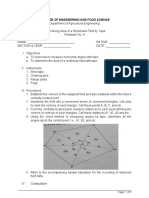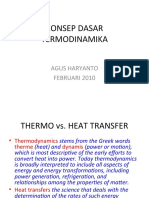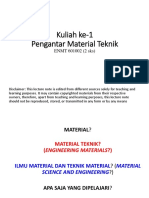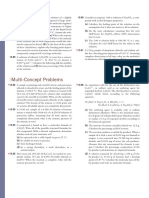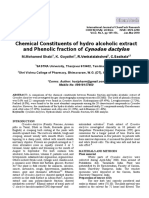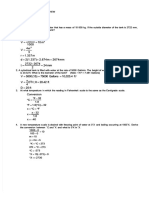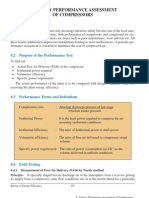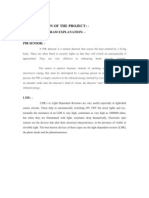Jurnal Referensi Polimer Anorganik (Sintesis Polisiloksan) PDF
Jurnal Referensi Polimer Anorganik (Sintesis Polisiloksan) PDF
Uploaded by
Fadli IkhsanCopyright:
Available Formats
Jurnal Referensi Polimer Anorganik (Sintesis Polisiloksan) PDF
Jurnal Referensi Polimer Anorganik (Sintesis Polisiloksan) PDF
Uploaded by
Fadli IkhsanOriginal Title
Copyright
Available Formats
Share this document
Did you find this document useful?
Is this content inappropriate?
Copyright:
Available Formats
Jurnal Referensi Polimer Anorganik (Sintesis Polisiloksan) PDF
Jurnal Referensi Polimer Anorganik (Sintesis Polisiloksan) PDF
Uploaded by
Fadli IkhsanCopyright:
Available Formats
Synthesis, characterization and properties of the polysiloxane-based
episulde resin
Xiaokang Lan
a,b
, Wei Huang
a,
*
, Yunzhao Yu
a
a
Institute of Chemistry, Chinese Academy of Sciences, Beijing 10080, PR China
b
Graduate University of Chinese Academy of Sciences, Beijing 10039, PR China
a r t i c l e i n f o
Article history:
Received 7 March 2010
Received in revised form 1 April 2010
Accepted 12 April 2010
Available online 24 April 2010
Keywords:
Episulde
Polysiloxane
Curing
Reactivity
Water absorption
a b s t r a c t
The polysiloxane episulde resin (PSER) was synthesized through replacement of the
oxygen atoms in 1,3,5,7-tetra-(3-glycidoxypropyl) tetramethylcyclotetrasiloxane (TGCS)
with sulfur atoms using potassium thiocyanate (KSCN). It was characterized by FT-IR,
1
H NMR, MS and elemental analysis. The PSER resin was a low viscosity liquid, stable at
room temperature. The polysiloxane episulde resin was very reactive: a mixture of PSER
and isophorondiamine gelated in a few seconds at room temperature. When m-phenylene-
diamine (m-PDA) or 2-ethyl-4-methylimidazole (2E4MZ) was used as curing agent, PSER
exhibited higher reactivity compared with the parent polysiloxane epoxy resin. The
reaction heat of the PSER resin was much lower in comparison with TGCS. The cured poly-
siloxane episulde resin showed higher glass transition temperature and much lower
water absorption, while the thermal stability was lower. It was found that meth-
ylhexahydrophthalic anhydride (MeHHPA) is not effective for curing the episulde resin,
although it is commonly used for curing epoxy resins.
2010 Elsevier Ltd. All rights reserved.
1. Introduction
Polysiloxanes are widely used in various areas for their
outstanding performance of high temperature resistance,
weathering stability, excellent dielectric properties, as well
as chemical and biological inertness [14]. It is therefore
interesting to implant polysiloxane to other polymer sys-
tems [59]. Great efforts have been made in developing
polysiloxane-modied epoxy resins, which are important
in electronic and microelectronic encapsulation for excel-
lent adhesive strength, good mechanical properties, easy
to process and low cost [1015]. For transparent optical
packaging materials, silicone epoxy resin systems are
being developed to overcome problems of macroscopic
phase separation and bleeding of the silicone component
[1619].
Episulde resins are the analogues of epoxy resins, in
which the oxygen atoms are replaced by sulfur atoms.
They have several advantages over epoxy resins: higher
curing reactivity, higher refractive index, good adhesion
to copper, higher glass transition temperature and lower
water absorption [2022]. These advantages make them
very promising in a wide range of applications including
optical resin, adhesives, microelectronic packaging, etc.
[2326].
This work is to communicate our recent studies on the
polysiloxane-based episulde resin. Polysiloxane episulde
resin (PSER) was synthesized through substitution of
1,3,5,7-tetra-(3-glycidoxypropyl) tetramethylcyclotetra-
siloxane with potassium thiocyanate (KSCN). The structure
of PSER was characterized by FT-IR,
1
H NMR, MS and ele-
mental analysis. Reactivity with different curing agents,
including m-PDA, 2E4MZ and MeHHPA, was studied by
differential scanning calorimetric measurements (DSC),
and the activation energies for these reactions were esti-
mated using Ozawas method. Thermal properties and
water absorption of the cured polysiloxane episulde were
studiedin comparisonwiththose of the parent polysiloxane
epoxy resin.
0014-3057/$ - see front matter 2010 Elsevier Ltd. All rights reserved.
doi:10.1016/j.eurpolymj.2010.04.011
* Corresponding author. Tel./fax: +86 10 62558109.
E-mail address: huangwei@iccas.ac.cn (W. Huang).
European Polymer Journal 46 (2010) 15451556
Contents lists available at ScienceDirect
European Polymer Journal
j our nal homepage: www. el sevi er . com/ l ocat e/ eur opol j
2. Experimental
2.1. Materials
Allyl glycidyl ether and 1,3,5,7-tetramethylcyclote-
trasiloxane (D4H) were industrial products and puried
by distillation before use. Lamoreaux platinum catalyst
(Pt catalyst) was a commercial product of Degussa. Thio-
urea and potassium thiocyanate (KSCN) were chemical
reagents purchased from Beijing Chemical Reagents Co.
and Sinopharm Chemical Reagent Co., Ltd., respectively,
and used as received. M-phenylenediamine (m-PDA),
isophorondiamine (IPDA), 2-ethyl-4-methylimidazole
(2E4MZ) and tetrabutylammonium bromide (N(C
4
H
9
)
4
Br)
were supplied by Beijing Xingjin Chemical Reagents Co.,
Tianjin Chemical Reagents Co., Ltd., Acros Organics and
Beijing Xingfu Institute of Fine Chemicals, respectively,
and used as received. Methylhexahydrophthalic anhydride
(MeHPPA) was a commercially available product of Lonza
(Italy).
2.2. Synthesis of 1,3,5,7-tetra-(3-glycidoxypropyl)
tetramethylcyclotetrasiloxane (TGCS)
To a 250 ml three-necked round bottom ask equipped
with a reux condenser, a thermometer, a nitrogen inlet
and a magnetic stirrer, allyl glycidyl ether (35.7 g,
0.31 mol), toluene (50 ml) and platinum catalyst (0.44
mg, 1.1 10
6
mol) were loaded. Then the temperature of
the reaction mixture was raised to 65 C, D
4
H (15 g,
0.0625 mol) was added in about 30 min and the reaction
continued for a further 2 h. The reaction mixture was
cooled to room temperature; the solvent and the excess
reactant were removed under 80 C/1 mm Hg to give TGCS
product, a colorless liquid. Yield: 41.5 g (95.4%).
1
H NMR
(CDCl
3
, d, ppm): 0.05 (s, 12H); 0.460.52 (t, 8H); 1.55
1.63 (m, 8H); 2.562.58 (d, 4H); 2.752.77 (d, 4H); 3.10
3.11 (m, 4H); 3.323.43 (m, 12H); 3.653.69 (q, 4H).
FT-IR (cm
1
): 2997, 2933, 1260, 1077, 909. MS: m/e 696.6
(719.523). Elem. Anal. Calcd. for C
28
H
56
O
12
Si
4
: C, 48.28%;
H, 8.04%. Found: C, 47.34%; H, 7.94%.
2.3. Synthesis of the polysiloxane episulde resin (PSER)
KSCN (9.72 g, 0.1 mol) and water (15 ml) were loaded
into a 100 ml three-necked round bottom ask equipped
with a mechanical stirrer and a thermometer. After the dis-
solution of KSCN, the mixture of TGCS (8.74 g, 0.0125 mol)
and ethanol (30 ml) was added in 5 min. The reaction
mixture was stirred for 24 h at 30 C and then poured into
a 250 ml separating funnel, 40 ml CHCl
3
was added. The
upper layer of aqueous solution was removed; the organic
phase was washed with deionized water to the neutral pH
and dried over anhydrous sodium sulfate. Then the solvent
was removed under 45 C/1 mm Hg to give the product
PSER, a light-yellow liquid. Yield: 8.59 g (90.0%).
1
H NMR
(CDCl
3
, d, ppm): 0.07 (s, 12H); 0.490.53 (t, 8H); 1.58
1.62 (m, 8H); 2.182.19 (d, 4H); 2.492.50 (d, 4H); 3.01
3.07 (m, 4H); 3.383.44 (m, 12H); 3.653.69 (q, 4H). FT-
IR (cm
1
): 2933, 2864, 1260, 1087, 617. MS: m/e 760.6
(783.623) Elem. Anal. Calcd. for C
28
H
56
O
8
S
4
Si
4
: C,
44.21%; H, 7.37; S, 16.84%. Found: C, 43.54%; H, 7.28%; S,
15.73%.
2.4. Curing procedure of the episulde resin
M-PDA, 2E4MZ and MeHHPA, were used to cure the
polysiloxane episulde resin and the parent polysiloxane
epoxy resin. The concentration of the curing agents was
calculated according to the stoichiometry when m-PDA or
MeHHPA was used; 1 weight part of N(C
4
H
9
)
4
Br was added
as accelerator per 50 weight parts of MeHHPA. Five parts of
2E4MZ was used for curing 100 parts of the resins. Curing
regime is given in Table 1.
2.5. Characterization of PSER
FT-IR spectra were obtained using a Perkin-Elmer 782
Fourier transform infrared spectrometer.
1
H NMR spectra
were recorded with a Bruker MSL-400 MHz NMR spectrom-
eter using CDCl
3
as solvent. Matrix-assisted laser desorp-
tion/ionization time-of-ight (MALDI-TOF) mass spectra
were obtained using a Bruker Biex III MALDI-TOF mass
spectrometer. Refractive index was measured at 25 C by
WZS-1 refractometer from Shanghai Optical Instrument
Factory. Viscosity was measured by Brookeld DV-II Pro
Viscometer. Differential scanning calorimetry (DSC) was
performed on a SII EXSTAR6000-DSC6220 and the thermal
gravimetric analysis (TGA) was carried out on a SII EX-
STAR6000-TGA6300 in nitrogen at a heating rate of
10 C min
1
. For equilibrium water absorptions, samples
of U50 mm 3 mm were used; weight changes were re-
corded after water saturation at 25 C.
3. Results and discussions
3.1. Synthesis and characterization of the polysiloxane
episulde resin (PSER)
Polysiloxane episulde resin can be obtained through
hydrolytic condensation of epoxide-bearing silane and
replacement of oxygen atoms of the epoxide with sulfur
Table 1
Curing regime for the polysiloxane episulde resin and the polysiloxane epoxy resin.
Curing system Curing temperature (C) Curing time (h) Post cure temperature (C) Post cure time (h)
PSER/m-PDA 120 3 150 4
TGCS/m-PDA 150 3 180 4
PSER/2E4MZ 120 3 150 4
TGCS/2E4MZ 150 3 180 4
1546 X. Lan et al. / European Polymer Journal 46 (2010) 15451556
atoms, such as the process described in the patent [27].
However, the structure of the resin was not well dened.
In this study we start from commercially available
tetramethylcyclotetrasiloxane. First, 1,3,5,7-tetra-(3-glyci-
doxypropyl) tetramethylcyclotetrasiloxane (TGCS) was
prepared through platinum-catalyzed hydrosilylation.
Then the oxygen atoms in TGCS were replaced by sulfur
atoms (Scheme 1). In this way polysiloxane episulde resin
(PSER) of well dened structure was obtained.
The reactant allyl glycidyl ether was usedin excess to en-
sure complete consumption of SiH bonds, residues of
which may lead to gelation in the subsequent episuldation
reaction. Completion of the hydrosilylation reaction was
indicated by disappearance of the FT-IR band at 2155 cm
1
and the
1
H NMR signals at 4.7 ppm. The characteristic
absorptionof the oxirane ring inthe FT-IRspectra was found
at 908 cm
1
(Fig. 1). The
1
H NMR spectrum with peak
assignments is presented in Fig. 2.
Si
CH
3
O
4
H
H
2
PtCl
6
Si
CH
3
O
4
CH
2
CH
2
CH
2
OCH
2
CH
2
CH
O
CH
2
CH
CH
2
O
CH
2
CH
CH
2
O
+
Si
CH
3
O
4
CH
2
CH
2
CH
2
OCH
2
CH
2
CH
O
+ KSCN
Si
CH
3
O
4
CH
2
CH
2
CH
2
OCH
2
CH
2
CH
S
+ KOCN
Scheme 1. Synthesis of the polysiloxane episulde resin (PSER).
3000 2500 2000 1500 1000
TGCS
Wavenumber(cm
-1
)
T
r
a
n
s
m
i
t
t
a
n
c
e
(
%
)
617
908
PSER
Fig. 1. FT-IR spectra for PSER and TGCS.
X. Lan et al. / European Polymer Journal 46 (2010) 15451556 1547
For converting epoxides to episuldes, thiourea and
potassium thiocyanates have been used [28,29]. It was
found that KSCN is preferable for the synthesis of PSER.
When thiourea was used, gelation took place more easily.
In the FT-IR spectra of PSER shown in Fig. 1, the charac-
teristic peak at 617 cm
1
due to the asymmetric deforma-
tion of episulde ring [20] was observed. At the same time,
the peak for the epoxide at 908 cm
1
disappeared. These
results indicate the complete replacement of oxygen atoms
by sulfur atoms. Comparing the
1
H NMR spectrum of PSER
with that of the parent epoxide, it is clear that the chemical
shifts of protons in the episulde group are less than that
of the protons in the epoxy group. It is reasonable on ac-
count of the difference in electronegativity of the elements.
Sulfur is less electronegative compared with oxygen;
therefore the protons in episulde groups are electroni-
cally better shielded.
The PSER resin obtained was a liquid of low viscosity
(1250 mPa s at 25 C); this is advantageous for application.
Refractive index (RI) of PSER was 1.51 at 25 C, signicantly
higher than that of the parent epoxy resin (RI 1.46). This is
just as expected, because the atomic refractive constant of
sulfur is higher than that of oxygen.
5 4 3 2 1 0 -1
Si
CH
3
O
4
CH
2
CH
2
CH
2
OCH
2
CH
2
CH
S
Si
CH
3
O
4
CH
2
CH
2
CH
2
OCH
2
CH
2
CH
O
1
2
1'
2'
3'
3
4'
5'
4
5
6'
6
7',8'
7,8
9
9'
1
2 3 6 4,5 7 8,9
1'
2' 3' 4',5' 6' 7' 8'9'
ppm
Fig. 2.
1
H NMR spectra for PSER and TGCS.
6 8 10 12 14 16 18 20 22 24 26
88
90
92
94
96
98
100
Time / h
1.0 1.2 1.4 1.6 1.8 2.0
84
88
92
96
100
C
o
n
v
e
r
s
i
o
n
o
f
e
p
o
x
y
g
r
o
u
p
(
w
t
%
)
Ratio of KSCN to epoxy group
Fig. 3. Effect of reaction time and the molar ratio of KSCN to epoxy group on the conversion.
CH
2
CH CH
2
CH
2
O CH
2
CH CH
2
S
Si
CH
3
O
4
H
H
2
P
t
Cl
6
+
CH
2
CH CH
2
CH
2
O CH
2
CH CH
2
O
CH
2
CH CH
2
CH
2
O CH
2
CH CH
2
S
KSCN
Scheme 2. The failed route for synthesis of PSER.
1548 X. Lan et al. / European Polymer Journal 46 (2010) 15451556
Inuences of the reaction temperature, the reaction
time and the molar ratio of KSCN to epoxy group on the
episuldation reaction were investigated. The reaction
temperature along 30 C is optimal. At temperatures lower
than 20 C, a long reaction time is needed to achieve com-
plete conversion of epoxide into episulde. This may bring
in a risk of gelation, as the formed episulde is not stable in
the alkaline reaction medium [30]. If the reaction is carried
out at temperatures higher than 45 C, polymerization of
the formed episulde also becomes remarkable, although
the time required for episuldation is shortened.
The conversion of epoxy monomer into episulde mono-
mer was estimated by the
1
HNMR spectra of the product. A
conversion curve is given in Fig. 3 for the reaction at 30 C
and molar ratio of KSCNto epoxy group at 2:1. It is seen that
conversion was completed after ca. 24 h. In this case poly-
merization of the formed episulde was insignicant. How-
ever, partial polymerization of episulde was noted when
100 150 200 250 300
-12.0k
-10.0k
-8.0k
-6.0k
-4.0k
-2.0k
0.0
2.0k
4.0k
6.0k
H
e
a
t
f
l
o
w
(
w
)
Temperature (
o
C )
PSER
TGCS
207.8
Fig. 4. DSC thermographs for TGCS and PSER.
50 100 150 200 250
-10.0k
-5.0k
0.0
5.0k
10.0k
15.0k
20.0k
25.0k
H
e
a
t
f
l
o
w
(
w
)
Temperature (
o
C)
PSER/m-PDA
PSER/2E4MZ
TGCS/m-PDA
TGCS/2E4MZ
Fig. 5. DSC thermographs for PSER and TGCS cured with m-PDA and 2E4MZ.
Table 2
Curing of the polysiloxane episulde resin and the polysiloxane epoxy resin
with m-PDA and 2E4MZ studied by DSC.
Composition T
onset
a
(C) T
p
b
(C) T
f
c
(C) DH
d
(J/g)
PSER/m-PDA 75.9 134.7 238.3 153.0
TGCS/m-PDA 130.0 169.1 254.3 354.0
PSER/2E4MZ 125.6 136.4 172.7 204.0
TGCS/2E4MZ 106.6 165.1 277.2 408.0
a
Onset temperature in DSC thermograph.
b
Exothermal peak temperature.
c
Exotherm ending temperature.
d
Heat of reaction.
X. Lan et al. / European Polymer Journal 46 (2010) 15451556 1549
the reaction time was extended to 36 h, and gelation took
place at 48 h.
The effect of the molar ratio of KSCN to epoxy group is
also shown in Fig. 3 where the temperature was set at
N HN
C
2
H
5
CH
3
CH
2
CH CH
2
O
1:1
addition
N NH
C
2
H
5
CH
3
CH
2
CH CH
2
O
+ R R
H
shift
N N
C
2
H
5
CH
3
CH
2
CH CH
2
OH
R + CH
2
CH CH
2
O
R
1:2
addition
N N
C
2
H
5
CH
3
CH
2
CH CH
2
OH
R CH
2
CH CH
2
R
O
+ CH
2
CH CH
2
O
R
N N
C
2
H
5
CH
3
CH
2
CH CH
2
OH
R CH
2
CH CH
2
R
O CH
2
CH CH
2
O
R
Polymer
polymerization
Scheme 3. Reactions of epoxide with 2E4MZ upon curing.
100 150 200 250 300
-15.0k
-10.0k
-5.0k
0.0
5.0k
10.0k
H
e
a
t
f
l
o
w
(
w
)
Temperature (
o
C)
PSER-MeHHPA
PSER-MeHHPA(NH
4
(C
4
H
9
)
4
Br)
TGCS-MeHHPA
TGCS-MeHHPA(NH
4
(C
4
H
9
)
4
Br)
Fig. 6. DSC thermographs for PSER and TGCS cured with MeHHPA.
1550 X. Lan et al. / European Polymer Journal 46 (2010) 15451556
30 C and reaction time 24 h. It is seen that complete con-
version was achieved when a molar ratio of 2:1 was
employed.
The alternative approach to the polysiloxane episulde
resin, in which episuldation of allyl glycidyl ether was
carried out rst as illustrated in Scheme 2, has been tried.
However, the followed platinum-catalyzed hydrosilylation
of the episulde was not successful because the platinum
catalyst was poisoned by episulde groups.
3.2. Reactivity of the polysiloxane episulde resin
As the CS bond is longer than the CO bond, the episul-
de ring is more stressed in comparison with the oxirane
ring. As a result, episulde compounds exhibited higher
activity in ring-opening reactions. Fig. 4 shows the DSC
curves for the polysiloxane episulde resin and the parent
polysiloxane epoxy resin, obtained at a heating rate of
10 C/min under a ow of N
2
gas. An exothermal peak with
onset temperature 191.0 C and top temperature 207.8 C is
seen in the DSC curve for PSER. The peaks are undoubtedly
ascribed to the thermal polymerization of the episulde. No
exothermal peak was observed for the polysiloxane epoxy
resin till 300 C.
Though the polysiloxane episulde resin exhibited high
reactivity in thermal polymerization, the resin was quite
stable at room temperature: it can be easily cast after stor-
age for two months without additive of stabilizer. Yet
bisphenol A type episulde resins are unstable at room
temperature, and weak acids are usually added as stabi-
0 50 100 150 200 250 300
-2k
-1k
0
1k
2k
Temperature (
o
C)
H
e
a
t
f
l
o
w
(
w
)
5
o
C/min
10
o
C/min
15
o
C/min
20
o
C/min
a
50 100 150 200 250 300
0.0
5.0k
10.0k
15.0k
20.0k
25.0k
H
e
a
t
f
l
o
w
(
w
)
Temperature (
o
C)
5
o
C/min
10
o
C/min
15
o
C/min
20
o
C/min
b
Fig. 7. DSC curves for (a) PSER/m-PDA and (b) TGCS/m-PDA at different heating rate.
X. Lan et al. / European Polymer Journal 46 (2010) 15451556 1551
lizer upon storage [31]. Good storage stability of PSER may
be related with high purity. The polysiloxane episulde re-
sin was a liquid of low viscosity; therefore alkaline impuri-
ties from the reaction mixture could be easily removed by
washing with water.
The episulde resin showed very high reactivity with
amines, especially aliphatic andalicyclic amines. The blends
of PSER with isophorondiamine (IPDA) gelated in a fewsec-
onds at room temperature. Even at 0 C, the gel time of the
mixture was less than 5 min. High curing reactivity at low
temperature is an outstanding advantage of the episulde
resin, which make it widely applicable in the elds such
as rapid-cure implants and instant adhesives [32].
Aromatic amine m-phenylenediamine (m-PDA) is less
reactive compared with IPDA; the gel time of the PSER/
m-PDA system was ca. 4 h at 25 C. The DSC thermograph
for the PSER/m-PDA system is shown in Fig. 5, with the
TGCS/m-PDA system for comparison; the results are sum-
marized in Table 2. It is seen that the exothermal peak
temperature for PSER/m-PDA was about 35 C lower than
that for TGCS/m-PDA. Obviously the episulde resin is
more reactive with aromatic amine compared with the
parent epoxide.
2E4MZ is a commonly used curing agent for epoxy res-
ins; the mechanism of curing is illustrated in Scheme 3
[33,34]. For the TGCS/2E4MZ system, three exothermal
peaks at 126.7 C, 135.9 C and 165.1 C, respectively, can
be seen in the DSC curve (Fig. 5). The former two peaks
can be attributed to the addition reactions and the third
peak can be attributed to homopolymerization of epoxide
100 150 200
-5.0k
0.0
5.0k
10.0k
15.0k
20.0k
25.0k
30.0k
35.0k
40.0k
45.0k
50.0k
5
o
C/min
10
o
C/min
15
o
C/min
20
o
C/min
Temperature (
o
C)
H
e
a
t
f
l
o
w
(
w
)
a
50 100 150 200 250 300
-4.0k
-2.0k
0.0
2.0k
4.0k
6.0k
8.0k
10.0k
12.0k
14.0k
16.0k
18.0k
20.0k
22.0k
24.0k
26.0k
Temperature (
o
C)
H
e
a
t
f
l
o
w
(
w
)
5
o
C/min
10
o
C/min
15
o
C/min
20
o
C/min
b
Fig. 8. DSC curves of (a) PSER/2E4MZ and (b) TGCS/2E4MZ at different heating rate.
1552 X. Lan et al. / European Polymer Journal 46 (2010) 15451556
initiated by the oxygen anion. However, in the case of
PSER/2E4MZ, only one sharp exothermal peak at 136.4 C
was observed. The curing of episulde/2E4MZ might pro-
ceed through the reactions similar to that shown in
Scheme 3, but the anionic homopolymerization of episul-
de took place at much lower temperatures. Therefore,
the exothermal peaks for the addition and the homopoly-
merization were merged in the DSC curve.
Heat release upon curing was calculated by integration.
It was found that the reaction heat of PSER was much low-
er than that of TGCS, whether m-PDA or 2E4MZ was em-
ployed as curing agent. Low heat release on curing of
episulde is advantageous for avoiding excessive stress in
the cured products.
Fig. 6 shows the DSC thermographs for the PSER/MeHH-
PA and TGCS/MeHHPA systems. For curing of the polysilox-
ane epoxy resin with anhydride, an accelerator is needed.
No exothermal peak was observed up to 300 C for TGCS/
MeHHPA without accelerator. An exothermal peak
appeared at 176.9 C with the addition of N(C
4
H
9
)
4
Br as
accelerator.
For the episulde/MeHHPA system without accelerator,
an exothermal peak was observed at 226.2 C in the DSC
thermograph, which is 18 C above the exothermal peak
temperature of PSER alone. It is likely that MeHHPA did
not react with episulde at all; or rather it hindered the
homopolymerization of episulde. It is also interesting to
note that the exothermal peak shifted to even higher tem-
perature with the addition of N(C
4
H
9
)
4
Br.
3.3. Curing kinetics of the polysiloxane episulde resin
The apparent kinetics of curing was investigated by DSC
scans at a series of heating rate. Fig. 7 shows the DSC scans
for PSER/m-PDA and TGCS/m-PDA. The peak temperature
raised with increasing heating rate as expected. Similar re-
sults are shown in Fig. 8 when 2E4MZ was applied as cur-
ing agent.
Assuming that (1) the peak exothermic (T
p
) represents a
point of constant conversion, (2) the curing reaction fol-
lows the rst order kinetics, (3) the temperature depen-
dence of the reaction rate constant obeys Arrhenius
equation, apparent activation energies (E
a
) of curing can
be calculated using Ozawas method [35,36]:
E
a
RDlog b
0:4567D1=T
p
where, E
a
, activation energy (kJ/mol); R, gas constant
(8.314 J/mol K); b, heating rate (C/min); T
p
, peak tempera-
ture (K).
2.0 2.2 2.4 2.6 2.8 3.0 3.2 3.4
0.7
0.8
0.9
1.0
1.1
1.2
1.3
PSER
PSER-m-PDA
PSER-2E4MZ
TGCS-m-PDA
TGCS-2E4MZ
1000/T
p
(K
-1
)
l
g
Fig. 9. Plot of log b vs. 1000/T
p
for PSER and TGCS.
Table 3
Activation energy for the curing of the polysiloxane episulde resin and the
polysiloxane epoxy resin.
Composition Activation energy (kJ/mol)
PSER 71.01
PSER/m-PDA 36.4
TGCS/m-PDA 60.2
PSER/2E4MZ 65.1
TGCS/2E4MZ 83.3
Table 4
Thermal properties of the cured polysiloxane episulde resin and the cured
polysiloxane epoxy resin.
Materials T
g
(C) T
d
a
(C) T
5
b
(C) Char
c
(%)
PSER/m-PDA 179.4 289.0 276.0 27.0
TGCS/m-PDA 160.5 413.2 395.1 29.7
PSER/2E4MZ 120.7 296.4 302.9 21.5
TGCS/2E4MZ 102.9 395.0 377.0 24.6
a
Decomposition temperature.
b
Temperature at 5% weight loss.
c
Residual char at 600 C.
X. Lan et al. / European Polymer Journal 46 (2010) 15451556 1553
Fig. 9 shows the plots of log b vs. 1000/T
p
for the cur-
ing of episulde and epoxide with different agents, and
for the polymerization of the episulde resin without
curing agent. For the TGCS/2E4MZ system, the peak tem-
perature of homopolymerization of epoxide was adopted.
E
a
values calculated from the slope of the lines are listed
in Table 3.
It is seen that E
a
for curing of the polysiloxane episulde
resin is much lower than that for the polysiloxane epoxy
resin with m-PDA and 2E4MZ as curing agent. In other
word, the polysiloxane episulde resin shows a much
higher reactivity with these curing agents. For both PSER
and TGCS, E
a
of the curing reaction with m-PDA was much
lower than that of curing reaction with 2E4MZ, i.e., the
addition of NH to episulde or epoxide takes place more
easily, compared with homopolymerization of episulde
or epoxide.
The difference between E
a
for the PSER/2E4MZ system
and E
a
for the neat PSER resin is marginal, ca. 6 kJ/mol. It
is likely that polymerization in the neat PSER resin pro-
ceeds by a similar mechanism as in the PSER/2E4MZ sys-
tem. In the PSER/2E4MZ system, anionic polymerization
of episulde is initiated by 2E4MZ, whereas in the neat
PSER resin anionic polymerization is initiated by heat.
Therefore, in the DSC thermograph the peak temperature
appears about 71 C earlier in the former case.
200 400 600 800
20
30
40
50
60
70
80
90
100
W
e
i
g
h
t
r
e
s
i
d
u
e
(
w
t
%
)
Temperature (
o
C)
PSER-m-PDA
PSER-2E4MZ
TGCS-m-PDA
TGCS-2E4MZ
Fig. 10. TGA thermographs for TGCS and PSER cured with m-PDA and 2E4MZ.
0 2 4 6 8 10
0.0
0.5
1.0
1.5
2.0
2.5
3.0 PSER-m-PDA
PSER-2E4MZ
TGCS-m-PDA
TGCS-2E4MZ
W
a
t
e
r
a
b
s
o
r
p
t
i
o
n
(
w
t
%
)
Time (d)
Fig. 11. Water absorption vs. time for cured resins.
1554 X. Lan et al. / European Polymer Journal 46 (2010) 15451556
3.4. Properties of cured polysiloxane episulde resins
Cured polysiloxane episulde resins were prepared
with m-PDA and 2E4MZ as curing agent. The curing
regimes are given in Table 1. The properties of the cured
resins were studied to illustrate the merit and disadvan-
tages of the episulde resin.
Glass transmission temperatures (T
g
) of the materials
determined by DSC are listed in Table 4. In general, T
g
of
the cured episulde resin was higher for about 20 C com-
pared with that of the corresponding epoxy resin when the
same curing agent was used. Certainly the CS bonds are
more difcult to rotate compared with the CO bonds;
thus the polymer chain in the cured episulde is more
rigid.
Fig. 10 shows the TGA graphs for PSER and the parent
epoxy resin cured with different agents. The decomposi-
tion temperature, the temperature for 5% weight loss and
the residual char at 600 C are summarized in Table 4. It
is seen that the episulde resin is less stable at high tem-
peratures whichever m-PDA or 2E4MZ was used as curing
agent. No wonder, the bonding energy of CS (272 kJ/mol)
is much lower than that of CO (326 kJ/mol). Poor thermal
stability of the CS bond is disadvantageous for the resin to
be used at high temperatures. On the other hand, however,
it may be helpful for the materials such as reworkable
underll.
Fig. 11 shows the water absorption vs. time at 25 C for
the cured PSER and TGCS. For all the cured resins, water
saturation reached in 78 days. The cured polysiloxane
episulde resins showed a much lower water absorption
compared with the cured epoxy resin whichever m-PDA
or 2E4MZ was used as curing agent. It was reasonable for
that the CS bond is less polar compared with the CO
bond. Low water absorption is very important for the
materials used in microelectronic packaging.
4. Conclusions
Polysiloxane episulde resin PSER of well dened struc-
ture was synthesized by replacement of oxygen atoms in
the polysiloxane epoxy resin TGCS with sulfur atoms using
potassium thiocyanate. Under the optimized reaction con-
ditions, a complete conversion of epoxide into episulde
was achieved. The structure of the polysiloxane episulde
resin was conrmed by FT-IR,
1
H NMR, MS and elemental
analysis. The polysiloxane episulde resin was a liquid of
low viscosity and it could keep stable for over two months
at room temperature. When IPDA was blended with PSER
resin, the gelation time of the mixture was only a few sec-
onds. The reactivity of the episulde resin and the parent
epoxy resin with m-PDA, 2E4MZ and MeHHPA was studied
by DSC measurements. The polysiloxane episulde resin
exhibited higher reactivity with m-PDA or 2E4MZ com-
pared with the polysiloxane epoxy resin. The heat release
of curing reaction for the polysiloxane episulde was much
less than that for the polysiloxane epoxy resin. MeHHPA
did not react with episulde effectively. Cured PSER exhib-
ited higher T
g
and much lower water absorption compared
with the cured TGCS. However, the thermal stability of the
cured PSER was much lower than that of the cured TGCS.
Acknowledgement
Funding from National Natural Science Foundation of
China (NSFC) (No. 50673092) is gratefully acknowledged.
References
[1] Noll W. Chemistry and technology of silicones. New York: Academic
Press; 1968.
[2] Voorhoeve RJ. Organosilanes, precursors to silicones. New York:
Elsevier Publishing; 1967.
[3] Bauer F, Glasel HJ, Decker U, Ernst H, Freyer A, Hartmann E, et al.
Trialkoxysilane grafting onto nanoparticles for the preparation of
clear coat polyacrylate systems with excellent scratch performance.
Prog Org Coat 2003;47:14753.
[4] Tsai MF, Lee YD, Long YC. Synthesis of a polydimethylsiloxane-block-
hydroxyl grafted acrylate prepolymer copolymer to improve the
adhesion between silicone rubber and polyurethane by induced
surface reconstruction. J Polym Res 2000;7:739.
[5] Yang CZ, Gu AJ, Song HW, Xu ZB, Fang ZP, Tong LF. Novel
modication of cyanate ester by epoxidized polysiloxane. J Appl
Polym Sci 2007;105:20206.
[6] Racles C, Avram E, Marcu M, Cozan V, Cazacu M. New siloxaneester
modied polysulfones by phase transfer catalysis. Polymer
2000;41:820511.
[7] Hou MH, Liu WQ, Su QQ, Liu YF. Synthesis of a novel phosphorus-
containing polysiloxane and its use as the modier of thermal
properties of an epoxy resin. Polimery 2007;52:83640.
[8] Fan QL, Fang JL, Chen QM, Yu XH. Synthesis and properties of
polyurethane modied with aminoethylaminopropyl poly(dimelthyl
siloxane). J Appl Polym Sci 1999;74:25528.
[9] Taskiran I, Ezdesir A, Sunal G, Uyanik N. Structural modication of
expandable polystyrene. II. Copolymerization with silicone acrylate.
J Appl Polym Sci 2006;101:12832.
[10] Ho TH, Wang CS. Modication of epoxy resin with siloxane
containing phenol aralkyl epoxy resin for electronic encapsulation
application. Eur Polym J 2001;37:26774.
[11] Ho TH, Wang CS. Synthesis of aralkyl novolac epoxy resins and their
modication with polysiloxane thermoplastic polyurethane for
semiconductor encapsulation. J Appl Polym Sci 1999;74:190516.
[12] Ho TH, Wang CS. Modication of epoxy resins with polysiloxane
thermoplastic polyurethane for electronic encapsulation. 1. Polymer
1996;37:273342.
[13] Ho TH, Wang JH, Wang CS. Modication of epoxy resins with
polysiloxane TPU for electronic encapsulation. II. J Appl Polym Sci
1996;60:1097107.
[14] Ahmad S, Gupta AP, Sharmin E, Alam M, Pandey SK. Synthesis,
characterization and development of high performance siloxane-
modied epoxy paints. Prog Org Coat 2005;54:24855.
[15] Hsiue GH, Wang WJ, Chang FC. Synthesis, characterization, thermal
and ame-retardant properties of silicone-based epoxy resin. J Appl
Polym Sci 1999;73:12318.
[16] Crivello JV, Lee JL. The synthesis, characterization, and photoinitiated
cationic polymerization of silicon-containing epoxy resins. J Polym
Sci Part A: Polym Chem 1990;28:479503.
[17] Huang W, Zhang Y, Yu YZ, Yuan YX. Studies on UV-stable silicone
epoxy resins. J Appl Polym Sci 2007;104:39549.
[18] Morita Y, Tajima S, Suzuki H, Sugino H. Thermally initiated cationic
polymerization and properties of epoxy siloxane. J Appl Polym Sci
2006;100:20109.
[19] Maneesh B, Shedric G. Epoxy-functional polysiloxanes, sliicone
composition, and coated optical ber. WO patent112943-A1
10.26.2006.
[20] Bell JP, Don TM, Voong S, Fernandez A, Ku W. Synthesis and
properties of epoxyepisulde resins. Makromol Chem 1996;240:
6781.
[21] Bell JP, Ku W. Epoxy/episulde resins. In: Sedlacek B, Kahovec J,
editor. Berlin: Walter de Gruyter, Inc.; 1987. [Chapter 1].
[22] Tsuchida K, Bell JP. A new epoxy/episulde resin system for coating
applications: curing mechanism and properties. Int J Adhes Adhes
2000;20:44956.
[23] Tsuchida K, Bell JP. New epoxy/episulde resin system for electronic
applications. I. Curing mechanism and properties. J Appl Polym Sci
2001;79:135970.
[24] Lu CL, Cui ZC, Wang YX, Yang B, Shen JC. Studies on synthesis and
properties of episulde-type optical resins with high refractive
index. J Appl Polym Sci 2003;89(9):242630.
X. Lan et al. / European Polymer Journal 46 (2010) 15451556 1555
[25] Konishi T, Hasegawa T, Miyata Y. Episulde-type resin composition
used as adhesive agent for electronic component, contains episulde
compound and mercaptan-type compound having thiol groups. JP
patent197578 09.08.2007.
[26] Konishi T. Liquid thermosetting resin composition for underlls in
semiconductor device, contains thermosetting resin, hardening
agent, episulde resin or episulde resin and liquid epoxy resin
and mercapto silane coupling agent. JP patent 149820 09.07.2009.
[27] Ochi M, Nakayama K, Oti M. Episulde group substituted silicon
compound for thermosetting resin composition for electric and
electronic material, has specic structure. WO patent 13396
01.02.2007.
[28] Dachlauer K, Jackel L. Process of preparing alkylene sulphides. US
patent 2094837 10.5.1937.
[29] Dachlauer K, Jackel L. Process of preparing alkylene sulphides. US
patent 2094914 10.5.1937.
[30] Sander M. Thiirane. Chem Rev 1966;66(3):297339.
[31] Amagai. Method of storing episulde compound. US patent 7309794
12.18.2007.
[32] Chino K, Suga K, Ikawa M, Satoh H. Novel rapid-cure adhesives for
low temperature using thiirane compound. J Appl Polym Sci
2001;82:29537.
[33] Chen P, Liu LZ. Curing mechanism, kinetic, reactivities of epoxy
resins system cured with 2-ethyl-4-methylimidazole. Acta Polym
Sin 1994;6:6416.
[34] Farkas A, Strohm PF. Imidazole catalysis in the curing of epoxy
resins. J Appl Polym Sci 1968;12:15968.
[35] Ozawa T. Kinetic analysis of derivative curves in thermal analysis. J
Therm Anal 1970;2:301.
[36] Duswalt AA. The practice of obtaining kinetic data by differential
scanning calorimetry. Thermochim Acta 1974;8:54.
1556 X. Lan et al. / European Polymer Journal 46 (2010) 15451556
You might also like
- ARF - 01 - Pendahuluan - Bahan Konstruksi Teknik Kimia (BKTK)Document13 pagesARF - 01 - Pendahuluan - Bahan Konstruksi Teknik Kimia (BKTK)nurmaNo ratings yet
- Chemicals For Every Day LifeDocument500 pagesChemicals For Every Day LifeAnonymous XX9Om322lNo ratings yet
- Chemicals For Every Day LifeDocument500 pagesChemicals For Every Day LifeAnonymous XX9Om322lNo ratings yet
- Chemicals For Every Day LifeDocument500 pagesChemicals For Every Day LifeAnonymous XX9Om322lNo ratings yet
- Determining Area of A Rectilinear Field by TapeDocument6 pagesDetermining Area of A Rectilinear Field by TapeLhizel Llaneta ClaveriaNo ratings yet
- Molecular Spectroscopy 2022Document120 pagesMolecular Spectroscopy 2022Lesedi mmabatho MashabelaNo ratings yet
- Bab Iv Hasil Dan Pembahasan: 4.1 Interpretasi Hasil Analisis XRD Menggunakan Aplikasi Match 3Document10 pagesBab Iv Hasil Dan Pembahasan: 4.1 Interpretasi Hasil Analisis XRD Menggunakan Aplikasi Match 3Reski FausiNo ratings yet
- Term Okimi ADocument39 pagesTerm Okimi ASri NurNo ratings yet
- Rahmanda Luthfia - 1906322796 - Tugas 1Document10 pagesRahmanda Luthfia - 1906322796 - Tugas 1Rahmanda LuthfiaNo ratings yet
- Tugas 5 - Self Assesment Test: KnownDocument3 pagesTugas 5 - Self Assesment Test: KnownJenny AzzahraNo ratings yet
- Laporan Unit 6 Anorganik Mutia SalsabilaDocument47 pagesLaporan Unit 6 Anorganik Mutia SalsabilaMutia SalsabilaNo ratings yet
- Cacat KristalDocument12 pagesCacat KristalBudi IstanaNo ratings yet
- CH-440 NanotechnologyDocument22 pagesCH-440 NanotechnologyAndrew SionNo ratings yet
- Soal Dan Jawaban Materi "The N-Well"Document7 pagesSoal Dan Jawaban Materi "The N-Well"Diamond RaviNo ratings yet
- Aktivitas Katalis Cr-Zeolit Dalam Reaksi Konversi Katalitik Fenol Dan Metil Isobutil KetonDocument8 pagesAktivitas Katalis Cr-Zeolit Dalam Reaksi Konversi Katalitik Fenol Dan Metil Isobutil KetonArif HidayatNo ratings yet
- International JournalDocument4 pagesInternational JournalBrahma Hakim Yuanda HutabaratNo ratings yet
- Sifat Arang Aktif Tempurung Kemiri Dan Pemanfaatannya Sebagai Penyerapan EmisiDocument80 pagesSifat Arang Aktif Tempurung Kemiri Dan Pemanfaatannya Sebagai Penyerapan EmisiKiki Rezki LestariNo ratings yet
- Effects of Storage Time On Molecular Weights and Properties of Melamine-Urea-Formaldehyde ResinsDocument12 pagesEffects of Storage Time On Molecular Weights and Properties of Melamine-Urea-Formaldehyde ResinsGNo ratings yet
- A Novel Validated UV Spectroscopy Method For The Determination of Prucalopride Succinate in Solid Dosage FormDocument8 pagesA Novel Validated UV Spectroscopy Method For The Determination of Prucalopride Succinate in Solid Dosage FormInternational Journal of Innovative Science and Research TechnologyNo ratings yet
- Aku Dan AntasenaDocument1 pageAku Dan Antasenaario bhismoNo ratings yet
- Konduktometri Jurnal KaiDocument9 pagesKonduktometri Jurnal Kaianggihalfiantara_178No ratings yet
- Soal - Try Out UAS Fisika KuantumDocument3 pagesSoal - Try Out UAS Fisika KuantumMega LialitaNo ratings yet
- Konduktometri PDFDocument7 pagesKonduktometri PDFYuliaKamilawatiIINo ratings yet
- 2 Struktur KeramikDocument93 pages2 Struktur KeramikMichael Robert Tua NababanNo ratings yet
- Answers To Self-Tests and ExercisesDocument50 pagesAnswers To Self-Tests and ExercisesALAN GUONo ratings yet
- Preparatory Problems PDFDocument2 pagesPreparatory Problems PDFGerel BayrmagnaiNo ratings yet
- Struktur KristalDocument22 pagesStruktur KristalReza AditiyaNo ratings yet
- Sintesis Nanoselulosa Dari Tongkol Jagung Dengan Perlakuan Hidrolisis Kimia Dan HomogenisasiDocument68 pagesSintesis Nanoselulosa Dari Tongkol Jagung Dengan Perlakuan Hidrolisis Kimia Dan Homogenisasimustika100% (1)
- A - 439180 - Luky Desyana Putri R - Tugas 2 Kesetimbangan KimiaDocument6 pagesA - 439180 - Luky Desyana Putri R - Tugas 2 Kesetimbangan KimiaLuky DesyanaNo ratings yet
- Artikel Ilmiah - Mukti Syarifah - Pembuatan Beras AnalogDocument9 pagesArtikel Ilmiah - Mukti Syarifah - Pembuatan Beras AnalogIfah SyarifahNo ratings yet
- Composite Rule of Mixture WNP 2020Document24 pagesComposite Rule of Mixture WNP 2020Frida ZaharaNo ratings yet
- Hand Book Bahasa Inggris Teknik KIMIA 1Document57 pagesHand Book Bahasa Inggris Teknik KIMIA 1AhmdMaulana100% (1)
- Activated SludgeDocument9 pagesActivated SludgeDwi Rezky WidiantoNo ratings yet
- Artikel FotolistrikDocument6 pagesArtikel FotolistrikAnwar Husen SadiliNo ratings yet
- Jurnal RedoksDocument7 pagesJurnal RedoksRohima Handayani100% (1)
- Tabel, Rumus Da Grafik Pitzer Perhitungan Gas NyataDocument5 pagesTabel, Rumus Da Grafik Pitzer Perhitungan Gas NyataSantri NdesaNo ratings yet
- Konsep Dasar Termodinamika: Agus Haryanto Februari 2010Document39 pagesKonsep Dasar Termodinamika: Agus Haryanto Februari 2010chitoz175No ratings yet
- Jadwal Kuliah Kimia FMIPA UnhasDocument7 pagesJadwal Kuliah Kimia FMIPA UnhasInul AkhyarNo ratings yet
- Pengantar Material TeknikDocument50 pagesPengantar Material TeknikbledsoeNo ratings yet
- Chapter 1Document5 pagesChapter 1Christian EduardoNo ratings yet
- Chapter6-Electrochemistry (Part 2)Document27 pagesChapter6-Electrochemistry (Part 2)Uswatun KhasanahNo ratings yet
- Ujian RemediDocument1 pageUjian RemediJokoSuswonoNo ratings yet
- Calcite Vs AragoniteDocument1 pageCalcite Vs AragonitewessilissaNo ratings yet
- Laporan Praktikum Anorganik Rekap 1 Seminar 2 (Recovered)Document17 pagesLaporan Praktikum Anorganik Rekap 1 Seminar 2 (Recovered)Myafitroh MartinaNo ratings yet
- Perry Hal 132-133 Densitas AirDocument2 pagesPerry Hal 132-133 Densitas AiraaNo ratings yet
- 2012 Intro OrganologamDocument43 pages2012 Intro OrganologamJodhi Hartono PutraNo ratings yet
- Appendix GeankoplisDocument11 pagesAppendix Geankoplisv dNo ratings yet
- Jurnal Internasional Tentang Identifikasi Gugus Fungsi 2 PDFDocument6 pagesJurnal Internasional Tentang Identifikasi Gugus Fungsi 2 PDFnadyah srimulyaniNo ratings yet
- Kuliah NMR 6Document20 pagesKuliah NMR 6Leni LismayantiNo ratings yet
- Paten Pembuatan Magnesium Klorida Dari Magnesium Hidroksida Dan Asam KloridaDocument6 pagesPaten Pembuatan Magnesium Klorida Dari Magnesium Hidroksida Dan Asam KloridaRaudhah AqilahNo ratings yet
- Viscosity of WaterDocument1 pageViscosity of WaterSuvadeep DalalNo ratings yet
- Electrochemical Degradation of Remazol Red RB 133 Using Sacrificial ElectrodesDocument23 pagesElectrochemical Degradation of Remazol Red RB 133 Using Sacrificial ElectrodesGlobal Research and Development ServicesNo ratings yet
- Mikromekanik KompositDocument24 pagesMikromekanik KompositAri P KusumaNo ratings yet
- Pembuatan Cis Dan Trans Kalium DioksalatodiakuokromatDocument10 pagesPembuatan Cis Dan Trans Kalium DioksalatodiakuokromatZulvana Anggraeni HarvianNo ratings yet
- Heri Septya Kusuma: BiographyDocument13 pagesHeri Septya Kusuma: BiographyAstrolabeNo ratings yet
- Sintesis Dan Karakterisasi Senyawa Kompleks ZnII-8Document5 pagesSintesis Dan Karakterisasi Senyawa Kompleks ZnII-8Rafika Firda Umamy HatibieNo ratings yet
- Refinement RIETICA ManualDocument27 pagesRefinement RIETICA ManualAstri AldelinaNo ratings yet
- Jawaban Dinamika KimiaDocument6 pagesJawaban Dinamika KimiaAprizhaMarfinaNo ratings yet
- Holman AppendixDocument18 pagesHolman AppendixMason PamelaNo ratings yet
- Tugas Munaa Masyu AbbasDocument17 pagesTugas Munaa Masyu AbbasBahtiar RNo ratings yet
- Coefficient of Friction of Composite Delamination Surfaces: Joakim SchonDocument13 pagesCoefficient of Friction of Composite Delamination Surfaces: Joakim SchonchawlakomalNo ratings yet
- Synthesis and Characterization of Oligosalicylaldehyde-Based Epoxy ResinsDocument5 pagesSynthesis and Characterization of Oligosalicylaldehyde-Based Epoxy ResinsFrancesca TeocoliNo ratings yet
- Novel Soluble and Thermally-Stable Fullerene Dyad Containing Perylene (Document5 pagesNovel Soluble and Thermally-Stable Fullerene Dyad Containing Perylene (Lodrick WangatiaNo ratings yet
- ja4c13528_si_001Document74 pagesja4c13528_si_001Yong-Sheng WeiNo ratings yet
- Acetylsalicylic Acid 99.pdf SIGMADocument5 pagesAcetylsalicylic Acid 99.pdf SIGMAFadli IkhsanNo ratings yet
- Corrosion Science: M.J. Muñoz-Portero, J. García-Antón, J.L. Guiñón, R. Leiva-GarcíaDocument11 pagesCorrosion Science: M.J. Muñoz-Portero, J. García-Antón, J.L. Guiñón, R. Leiva-GarcíaFadli IkhsanNo ratings yet
- GRAFIKDocument1 pageGRAFIKFadli IkhsanNo ratings yet
- Materi 2 - Absorption MicrosDocument20 pagesMateri 2 - Absorption MicrosFadli IkhsanNo ratings yet
- Cutting List Template Revised 16-06-08Document3 pagesCutting List Template Revised 16-06-08tlcpinedaNo ratings yet
- Beams V M GraphicalDocument3 pagesBeams V M GraphicalJoshua BacunawaNo ratings yet
- PGT25DLE MaintenanceDocument61 pagesPGT25DLE Maintenanceolegprikhodko280950% (2)
- LAB 5 Permeability TestDocument9 pagesLAB 5 Permeability TestHanis RahamanNo ratings yet
- SDM Individual AssignmentDocument2 pagesSDM Individual Assignmentchroeun sokayNo ratings yet
- Datasheet Vibratek Hold Down ClampDocument1 pageDatasheet Vibratek Hold Down ClamptylerstearnsNo ratings yet
- 01 Introduction To Multiphase MeteringDocument11 pages01 Introduction To Multiphase Meteringmangara.ip.perenco100% (1)
- LXM23D and BCH Servo Drive System Product ManualDocument403 pagesLXM23D and BCH Servo Drive System Product ManualLau Yuk LunNo ratings yet
- Electrical Steel NGO 35PN250Document6 pagesElectrical Steel NGO 35PN250Chandan Kumar100% (1)
- 2010 Pure Mathematics Paper 2Document7 pages2010 Pure Mathematics Paper 2dream7net5No ratings yet
- Free Jet LabDocument7 pagesFree Jet Labaeroscribble0% (1)
- Top 10 Photography Composition RulesDocument13 pagesTop 10 Photography Composition RulesindraharisNo ratings yet
- P-Diagram - Project Marcel Transmission SystemDocument1 pageP-Diagram - Project Marcel Transmission SystemkumarNo ratings yet
- Gujarat Technological UniversityDocument2 pagesGujarat Technological UniversityHet ShahNo ratings yet
- Sipart Dr21 6DR 210 - : Edition 04/2003Document242 pagesSipart Dr21 6DR 210 - : Edition 04/2003Muhammad Irfan EffendiNo ratings yet
- Altronic - Digital Annunciatior DD-40NTV-O & 40NTV-U PDFDocument35 pagesAltronic - Digital Annunciatior DD-40NTV-O & 40NTV-U PDFNESTOR MIGUEL PEREZNo ratings yet
- Nonlinear SystemsDocument24 pagesNonlinear SystemsUJJAWAL KUMARNo ratings yet
- Course Handout Math-I (Ma 1003)Document5 pagesCourse Handout Math-I (Ma 1003)012ANTARA DUBEYNo ratings yet
- Determinants and MatricesDocument13 pagesDeterminants and MatricesIsha MancenidoNo ratings yet
- Modern Physics 2009Document133 pagesModern Physics 2009Agres Krismantona67% (3)
- PDF ThermodynamicsproblemDocument122 pagesPDF ThermodynamicsproblemMsAzeal MoranteNo ratings yet
- Chapter1&2 2023 - 2024Document85 pagesChapter1&2 2023 - 2024Sulaiman ObaidNo ratings yet
- Advanced Motion Controls Dprahie-060a400Document11 pagesAdvanced Motion Controls Dprahie-060a400ElectromateNo ratings yet
- Permanent Deformation Model Using Creep in AbaqusDocument326 pagesPermanent Deformation Model Using Creep in AbaqusChristopher Gaines100% (1)
- En 1149-5-2008Document9 pagesEn 1149-5-2008Daniela Serna PulgarinNo ratings yet
- Effects of Column CreepDocument11 pagesEffects of Column CreephemalcmistryNo ratings yet
- UtilityDocument8 pagesUtilityAmit JainNo ratings yet
- Set Theory: Prof. Asim Tewari IIT BombayDocument22 pagesSet Theory: Prof. Asim Tewari IIT BombayScion Of VirikvasNo ratings yet
- Main Pir Sensor SpecificationDocument16 pagesMain Pir Sensor Specifications_aishwaryaNo ratings yet


